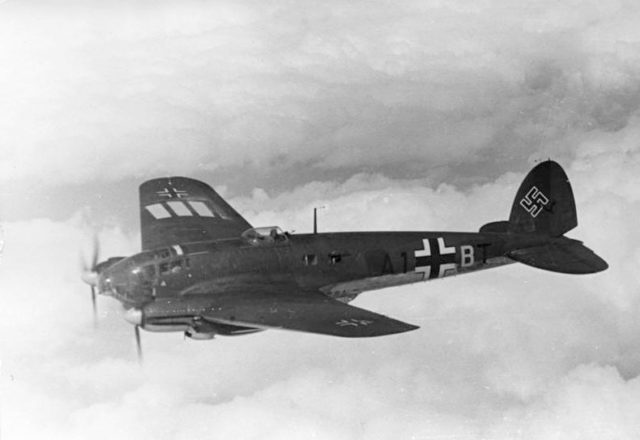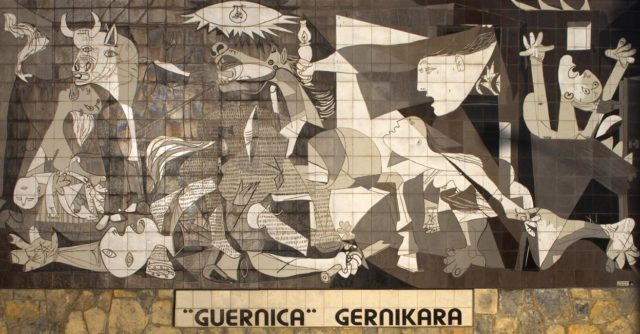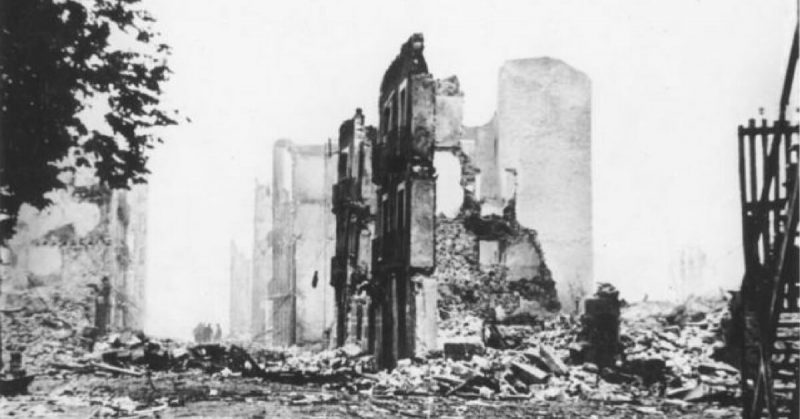The Bombing of Guernica was one of the first aerial raids on defenseless civilians ever to happen. It occurred on April 26th, 1937, in the thick of the Spanish Civil War. It was carried out by the Nazi German “Condor Legion” and the fascist Italian Air Force, on behalf of the Spanish Nationalist Government. The attack destroyed much of the city and killed many citizens. While the exact number of citizens killed has changed over the years (and depending on who you talk to), the consensus is that anywhere from 150 to 1,650 people died in the bombings.
Pre-Bombing
Before the bombing, Spain had been involved in a civil war for nine months. On one side were the Republicans who were backing the Spanish Republic that had been in place since 1931, while on the other side were the Nationalists, who wanted to remove the republic system in place.
Where does Guernica fall in all of this? Guernica is located in the northeast of Spain, in Basque Country, about 30 kilometers from Bilbao. The Nationalists began chewing away at the territory controlled in this area. Guernica was a buffer from the Nationalists getting to Bilbao, where the Republicans were and where those who were in harm’s way would retreat to. Bilbao was sought as it would likely put an end to the war in the north if the Nationalists took it over.
Diaries found in the 1970s state that the main reason for the bombing was to advance Nationalist troops in the area, and to support the troops that Generalissimo Fransisco Franco had in place in the region. The plan to bomb Guernica was put into play in the latter part of March 1937. General Franco began having towns to the north and east of Guernica attacked. These attacks were led by General Emilio Mola. Over the next month, these towns would be attacked, and the citizens would flee and take refuge in both Guernica and Bilbao.
On April 25h, General Mola warned Franco that his men would be bombing Guernica soon and that resisting would be useless; the best way to survive would be to surrender.
The Attack

The attack was to be heavy. It carried the codename, Operation Rugen. To meet these expectations, One Dornier Do 17, two Heinkel He 111s, 18 Ju 52 Behelfsbomber and three Italian SM.79s were brought in for the bombing. In total, the planes carried 22 tonnes of explosives ranging from 550 medium explosive bombs to 2.2-pound bombs.
The bombing began at 4:30 p.m. with the Dornier Do 17 dropping 12 110 pound bombs. Following this, the Italian SM.79s arrived with orders only to bomb bridges to the east of the city to limit any retreats. The SM.79s dropped 36-110 pound bombs on these parts. Damage to the city at this point was relatively light, with only a handful of buildings suffering minor damage.
The bombings continued until seven p.m., with wave after wave of planes coming in and dropping bombs at varying points of the city. This was when the city took the brunt of its damage. Towards the end of the bombings, planes were advised to begin bombing roadways exiting the city. The bombing of these roads lasted for about 15 minutes and added immensely to civilian deaths.
The Result
The bombings severely hampered the city’s ability to resist being overtaken. Just two days later the Nationalists were able to fully overtake the city. In their attempt to do so, they had almost completely destroyed the city. Most of the buildings in the city suffered damage with about 75 percent being completely destroyed. One of the Nationalists’ goals was to destroy the factories within the city, of which one was an ammunition plant. None of the factories were completely destroyed, and as a result, the Nationalists looked at the bombing as a failure.
The bombings affected not only the city’s buildings but also the city’s population. Guernica had a population of 7,000 before the bombing. Estimates range from 150-1600 were killed in the attack. The Spanish claim only 150 civilians were killed, while Russia claimed the number to be around 800 and the English claimed it to be around 400. The Basque Government had the largest claim, saying over 1,600 people had died in the attack.
As a result of all of this, the attack is often viewed as a terror bombing by the people of the Basque Country. It is also thought of as one of the Luftwaffe’s first attempts at Carpet Bombing, which they began utilizing in September of 1937 in the Battle of El Mazuco.
Reception
At first, the Nationalists’ had tried to claim that the attack was actually led by the Republican movement. This was debunked by a British reporter, George Steer, of The Times. He had been covering the Spanish Civil War within the country and his article was quickly syndicated to the New York Times, and from there it was published around the world. Steer pointed out that the Germans were involved in the attack, which caused widespread outrage as the Germans had signed the Non-Intervention Pact. His claims were supported by other journalists, which helped aid in public belief of his accounts. Because of this, there is still a lot of emotion within the Basque region in regards to the attacks.
Art

In response to the attacks, Spanish artist Pablo Picasso painted Guernica. The painting is done in grey, black, and white and conveys an anti-war message. Today, Guernica is regarded as one of the most powerful paintings with an anti-war message.
Germany Apologized
On the 60th anniversary of the event in 1997, German President Roman Herzog apologized for the event on behalf of all German citizens in writing to the survivors of the bombing. He apologized not only for the bombing of Guernica but also the role the Germans played in the Spanish Civil War.
